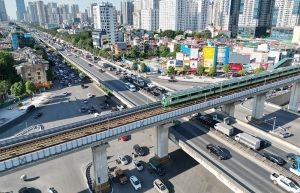Green and smart transition to address urban challenges
According to the Vietnam urban and rural planning for this decade, the country’s urbanisation rate is expected to exceed 50 per cent by 2030. As a result, environmental challenges such as air pollution, the loss of green spaces, and infrastructure problems will become significant issues for large cities in Vietnam as they strive to become greener and smarter.
 |
| Hanoi has for the first time won awards for smart infrastructure and smart public services at the Vietnam Smart City AwardsPhoto: BRG |
Nguyen Hoang Phuong, a senior expert at netzero.vn, told VIR last week that urbanisation leads to a boom in personal vehicles and industrial activities in cities. Furthermore, the construction and expansion of urban areas often create fine dust and emissions. As a result, air quality deteriorates, especially in major cities like Hanoi.
“Moreover, the rapid rate of urbanisation in Vietnam is causing green spaces to shrink, due to population pressure that leads to the conversion of agricultural and forest land into residential areas. This results in an imbalance in the urban ecosystem, reducing the ability to absorb CO2 and regulate natural air circulation,” Phuong said.
Hanoi has developed concrete solutions for its transition towards a greener, smarter city. These include a 2022 resolution on digital transformation and the establishment of Hanoi as a smart city, and a programme on promoting sci-tech and innovation in the capital, among others.
Minister of Information and Communications Nguyen Manh Hung said, “The environmental sector has been directed to apply the Internet of Things and AI to monitor air and water quality, as well as manage waste. Moreover, technology will also be used to optimise resource and energy management to reduce consumption. Of course, investment in renewable energy is indispensable, as it plays a crucial role in minimising environmental pollution.”
Luu Thi Thanh Chi, deputy head of the Department of Environmental Protection under the Hanoi Department of Natural Resources and Environment, argued that while technology plays a vital role, there are still practical and more accessible solutions the department is currently pushing forward, waiting for approval.
“To reduce sources of air pollution, the department, along with other stakeholders, has eliminated over 99 per cent of traditional charcoal stoves in Hanoi, and reduced straw burning by 80 per cent in suburban areas. Additionally, hundreds of small brick kilns have been dismantled,” she said. “We are also piloting emissions testing on old motorcycles and motorbikes still in circulation in the capital to gather data for proposing solutions to improve air quality.”
Other measures mentioned by Thanh Chi include strengthening inspections and addressing pollution caused by industrial facilities, construction projects that do not meet environmental standards, as well as increasing street cleaning and waste collection efforts.
 |
| Hanoi hosted the Vietnam-Asia Smart City Summit 2024 |
Notably, 2025 will mark the first year of Hanoi’s low-emission zone (LEZ) programme, meaning Hanoi will become a restricted area for highly polluting vehicles to improve air quality.
LEZ aims to encourage the use of green transportation and enhance quality of life, including initiatives such as emission label stickers for cars, motorcycles, and other vehicles based on emission levels, Thanh Chi explained.
“There will also be infrastructure for traffic monitoring to track vehicles entering, as well as the establishment of information systems and traffic signage to enforce restrictions or charges within the zone,” she said. “Additionally, public transportation and road infrastructure will be reorganised, and there will be support for residents and workers in the LEZ to transition from fossil-fuel vehicles to clean energy, zero-emission transportation.”
The pilot will take place over five years in Hoan Kiem district, and from 2031 onwards, other areas of the city must comply with the regulations based on criteria outlined in the Capital Law.
For urban planning and architecture, key strategies for creating a green and smart city have been developed, with a focus on smart urban planning, green architecture, and sustainable urbanisation.
Minister Hung said, “The urban planning sector has been instructed to utilise AI and big data for sustainable city planning, with multi-functional living spaces that adapt over time, intelligent systems, and preservation of urban identity. There will also be a focus on promoting green architecture in urban design.”
Hung also highlighted that the construction sector, closely related to urban development, has been given clear directives to incorporate technology into management and oversight, but more importantly, to use environmentally friendly building materials and advanced construction technologies.
Beyond local efforts, Vietnam is also cooperating with Denmark, a pioneer in sustainable urban development, through the reconstruction of infrastructure, something Hanoi could learn from.
Henriette Vamberg, managing director at Gehl Architects, a Denmark-based urban research and design consulting firm, suggested that urban design must consider the lifestyle habits and needs of residents, including children.
“One characteristic of Danish capital Copenhagen is its cycling culture, with 62 per cent of people cycling to work or school,” Vamberg said. “To ensure children can safely bike to school and develop physically and intellectually, air quality must be considered, as 90 per cent of children’s brain development happens before the age of five. This means children breathe faster than adults, which results in them absorbing harmful pollutants at a much higher rate if the air is polluted.”
As a result, Gehl has worked with third parties such as Google Street View, Utrecht University, and Copenhagen Solutions Lab to track emission flows and create maps of the city. The initiative also includes collecting data on children’s activities, commuting times, and areas with high concentrations of children, to suggest green routes for children and identify areas in need of improvement.
“The process of improving infrastructure to ensure parents can confidently let their children bike to school has taken decades, with continuous investment,” Vamberg added.
Although environmental issues remain a challenge, on December 3, Hanoi’s smart city development achieved recognition when the capital received two awards from the Vietnam Software and IT Services Association in the categories of “Smart Infrastructure City” and “Smart Public Services City”.
According to the association’s assessment, Hanoi has activated electronic identification accounts on the VNeID app for officials, party members, civil servants, employees, and workers, achieving a 99.99 per cent activation rate.
 |
| Hanoi aimed to install approximately 2,000 5G stations by the end of 2024, further enhancing connectivity across the capital |
The 4G mobile network and fibre optic infrastructure have been deployed to all communes, wards, and towns. The smartphone penetration rate has reached 90 per cent, and the broadband mobile subscription rate stands at 121 per cent. It is expected that companies will imminently install approximately 2,000 5G stations throughout Hanoi.
Hanoi currently has 16 out of 33 data centres, and is one of five cities chosen by the government to pilot the model of public administrative service centres and was the first unit to put this model into operation.
| Nguyen Ba Nguyen, deputy director, Planning and Architecture Department Ministry of Construction The adjustment of the master plan for Hanoi towards 2045 represents a crucial milestone in our city’s growth and development. This adjustment aims to ensure Hanoi’s growth remains sustainable, modern, and responsive to the future needs of our citizens and businesses. Our goal is to create a Hanoi that is not only a capital of national importance but also a smart, green, and thriving city that can meet the challenges of the future. To achieve this vision, we will focus on several key areas. Firstly, we must ensure that the adjustments align seamlessly with the broader goals outlined in the Hanoi master plan. This will create a strong foundation for coordinated development and ensure a balanced, integrated approach to our city’s growth. Secondly, we must revise and update our projections for population growth, labour trends, and economic development. These forecasts are vital for planning the infrastructure and services that will meet the needs of an expanding, dynamic city. We should build upon the existing structural model established in the 2011 Hanoi master plan, refining it to reflect the evolving needs of our economy and society. Additionally, we should introduce more effective measures for managing urban space and controlling development. As Hanoi grows, it is crucial to preserve our green spaces and historical areas while facilitating modern urbanisation. To support this, we will propose specific solutions for managing the city’s infrastructure, ensuring that it can support future growth while remaining sustainable and efficient. Additionally, we will focus on the regeneration of existing urban areas to ensure that older neighbourhoods continue to thrive in the face of new challenges. This is essential to preserving the identity and culture of Hanoi while embracing modernisation. Tran Ngoc Linh, expert Urban Development Agency Ministry of Construction One of the main challenges we face is the insufficient promotion of urban planning and smart urban management. There is a noticeable lack of legal frameworks to guide and support these efforts. For instance, the transition from traditional computer-aided design systems to geographic information systems has been slow, despite its importance in improving urban management efficiency. This delay is due to a number of factors, including a lack of a clear and unified strategy to drive this transition. While smart urban development has been mostly centred around providing services and amenities tied to e-government services, we must ask ourselves whether this is enough, or if we need to adopt a more comprehensive and coordinated approach. Another major issue is the absence of a solid mechanism for mobilising resources to develop smart cities. The links and partnerships between the public sector, private enterprises, and the broader economy are not as strong as they could be. As a result, the contributions from the private sector and society are often fragmented and uncoordinated, preventing us from leveraging the full potential of these resources. There is also a lack of a shared database and insufficient data connectivity across sectors. Without standardised and interconnected data systems, our ability to make informed decisions and ensure sustainable urban development is severely hindered. Additionally, the personnel available for urban management and technical expertise are limited in both number and capacity. This shortage is further compounded by disorganisation in the implementation of smart city projects, resulting in delays and inefficiencies. |
 | Hanoi's state budget revenue surpasses projections Amidst the global and domestic challenges of 2024, the capital's economy has maintained recovery momentum, exceeding key targets and achieving remarkable progress across multiple sectors. |
 | Hanoi seeks to transform urban agriculture Hanoi is enhancing its urban agriculture with high-tech and ecological farming models, with efforts directed towards concentrated production areas and planning challenges for sustainable growth. |
 | Sales of consumer goods and services in Hanoi reach VND780 trillion Total retail sales of consumer goods and services in Hanoi in the first 11 months of 2024 reached VND780.1 trillion ($32.5 billion), up 10.9 per cent on-year. |
 | Capital creates space for high-tech FDI capital influx Hanoi is leveraging opportunities to promote investment in the high-tech sector, especially the emerging semiconductor industry. |
 | Hanoi boosts night offerings but still trails rivals The number of night tourism products in Hanoi has quadrupled within just one year, making a significant contribution to the local budget’s revenue, but city authorities admit more can be done to compete with other cities. |
What the stars mean:
★ Poor ★ ★ Promising ★★★ Good ★★★★ Very good ★★★★★ Exceptional
Related Contents
Latest News
More News
- Protect what’s next: towards a future free from meningococcal group B disease (December 05, 2025 | 18:00)
- New ILO report offers policy recommendations for disability inclusion (December 04, 2025 | 15:18)
- Maternal job loss may affect children’s mental health, research shows (December 03, 2025 | 19:11)
- Women lead Vietnam’s shift to climate-resilient agriculture (December 03, 2025 | 19:10)
- Experts highlight unpaid care work as key barrier to gender equality (December 03, 2025 | 15:15)
- Opportunities and inequalities for women workers in Vietnam's garment industry (December 03, 2025 | 09:00)
- Vietjet flights carry love to devastated central region (November 28, 2025 | 11:35)
- New initiative to boost the fight against domestic violence (November 26, 2025 | 10:00)
- South Korea funds IOM relief for Vietnam’s typhoon-affected communities (November 24, 2025 | 15:33)
- AI and human-centred values set to shape the future of HR in Vietnam (November 21, 2025 | 18:04)

 Tag:
Tag:






















 Mobile Version
Mobile Version